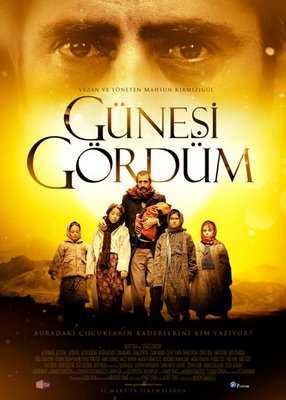I Saw The Sun/Günesi Gördüm (Mashun Kirmizigul, 2009): Turkey
Reviewed by Lava Farmer. Viewed at the Santa Barbara Film Festival.
Writer and Filmmaker, Mashun Kirmizigul, explores just about every tragic issue that a countryside village of families could be faced with in his film I Saw The Sun. In the midst of a brutal war, the families are forced to immigrate somewhere safer and leave behind their quaint and simple community. The families travel to Istanbul where Isa Atlun(Macit Sonkan) and Haydar(Erol Demiroz) choose to stay and raise their family. Davut Atlan(Altan Erkekli) chooses to flee Turkey and seeks the help of a smuggler to move his family to Norway. While trying to adapt and adjust to their new lives, the displaced villagers find relentless hardships around every corner.
As Haydar works hard to take care of his family, his wife becomes ill and he must struggle to keep things running smooth. Their oldest child Kadri(Cemal Toktas) meets a friendly transvestite named Cansu(Cern Aksakal) who introduces him to a world of sexual liberation where he is able to be himself and feel accepted. However, his brothers are disgraced by his behavior and refuse accept him, forcing him to flee from their hatred and abuse. Meanwhile, Davut and his family fight to acclimate to life in Norway where they face deportation and the challenges of starting a life in a new country. It’s somewhat overwhelming how many challenges these poor characters are affronted by. Kirmizigul kind of beats to death his theme of suffering.
Kirmizigul uses point of view to help give us different perspectives of what the characters are feeling. Point of view shots from a helicopter, then a military general expose the vulnerability of the naïve farmers. Point of view shots from Haydar’s perspective show his love and devotion to his family and the pride he has in them. In one scene as his children are taken away by child protective services, we are given a shot from his perspective as he falls to the ground in devastation. This use of perspective gives the film a mood of intimacy.
The use of juxtaposition makes visually enticing contrasts and comparisons. The vast and stunning landscape of the Turkish countryside is a stark contrast to the hectic, crowded city of Istanbul. In a scene where Haydar is told the terrible news that his youngest son has died he drops a tray of fish and falls to the floor in a fit of screaming and convulsions. A shot of the fish flopping recklessly around him only serve to emphasize his mood and enhance the intensity of the moment.
Lighting is practically the most important element of the cinematography and beautifully enhances the story. In the beginning of the film the two oldest sons of Davut face each other dramatically in a moment of sibling rivalry. As they stare at each other face to face, the soldiers face is illuminated by light and his rebel brother is cast over by shadow. This represents the distinction between the two sides of a warring nation. Throughout the film silloettes in the setting sun occur repeatedly and seem to highlight strength and hope. The final scene with the death of Kadri, however, is a sunrise that brings light and hope for a new day.
This dramatic and tragic tale gives audiences a look at a difficult way of life that is the true and actual fate of hundreds of villagers who are displaced by war.
About this entry
You’re currently reading “I Saw The Sun/Günesi Gördüm (Mashun Kirmizigul, 2009): Turkey,” an entry on Student Film Reviews
- Published:
- 02.21.10 / 7pm
- Category:
- Films, Santa Barbara Film Festival 2010

1 Comment
Jump to comment form | comments rss [?] | trackback uri [?]